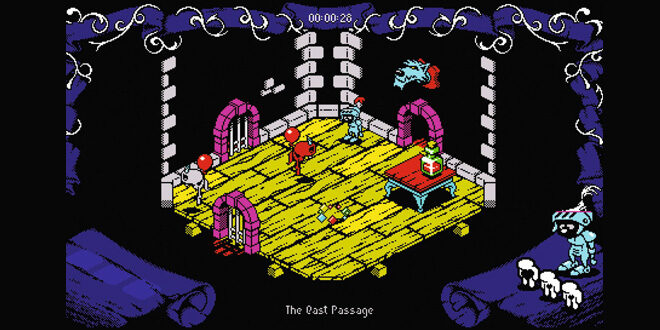It’s been more than 20 years since I’ve seen Richard Jordan. Our first exchange in 1998 was prior to him being photoshopped into a spacesuit to illustrate an article I’d overseen for PC Zone magazine about his fascination with remaking classic 8-bit games, one of which was a tribute to Jetpac he had been working on at the time.
Our meeting this time is to commemorate the recent release of Melkhior’s Mansion, a spiritual successor to Atic Atac; another of his efforts to be based on a game from the early years of Rare, when the Sea of Thieves developer was known to all as Ultimate Play the Game. Sadly, on this occasion, since we lack the resources to digitally dress Jordan into some wizard’s robes, I was hoping he’d aged sufficiently for it not to be necessary. Alas, that appears not to be the case. Of course, I don’t tell him that.
HUNGRY LIKE THE WULF
In the many years since our previous communication, Jordan has programmed six game remakes, many of them assembled during evenings, weekends and days off, with no remuneration given or expected. Melkhior’s Mansion is the most recent of them, and the fact that it’s been three and a half years in the making should give an idea that it’s not your typical fan recreation. I would go as far as to call it a natural successor to Atic Atac, which is a step up from the spiritual. In combining a little of the magic of not just Atic Atac, but the best of the Sabreman games (Sabre Wulf and Knight Lore, both released in 1984), Melkhior’s Mansion has the sort of quality and all the charm you’d expect from Rare itself, were it ever inclined to even return to the games with which it made its previous name.
“It’s a tribute,” says Jordan, bristling a little at the comparison, which is understandable given that the original remains his favourite game. “It started out life as a straightforward remake” – his second – before he started experimenting, “to see if Atic Atac would work in isometric. It did, and so it evolved into a full blown project.” After a few months, Jordan teamed up with Craig Steveson, whose Spectrum-inspired art has graced the cover of Edge magazine. He quickly put together some sample room graphics using the Spectrum’s colour palette, minus the machine’s infamous and endearing attribute limitations. “I was blown away by his pixels, so imagining an entire game looking like that really made things take off.”

LORE AND ORDER
It’s tricky to describe Atic Atac to those who’ve never experienced it, but we’ll have a go: You choose one of three characters and you go from room to room, trying to escape the castle. Doors open and close on their own, every few seconds, which often means you are locked on each screen-filled room or corridor, forced to endure the enemies that spawn soon after you enter and thereafter until you leave. Some coloured doors require a matching key. Some rooms have secret portals or trapdoors. Other rooms have special enemies that can’t be destroyed but can be held at bay if you have the right item, a cross, for example, that will cause a vampire to walk away rather than towards you. In the 80s we called Atic Atac an action adventure and everyone knew what that meant. Today, I dunno. Resident Evil meets Geometry Wars?
Knight Lore toned down the action a little, but not by much. It was a technical marvel, shifting from a top down to an isometric perspective, with more precision required and the time pressure of changing from human into werewolf as the game clock ticked around. Most take it to be Ultimate’s best game, perhaps even the Spectrum’s too, but I’m with Jordan.
“Atic Atac is probably my favourite Ultimate game, and Melkhior’s Mansion is my second take. There was no plan other than to create an isometric version of Atic Atac,” says Jordan. “It evolved into more than that, but we just made it up as we went along. I could literally be coding something and an idea for something else would pop into my head, so I’d put down the feature I was working on and tinker with the new idea.” Jordan puts Melkhior’s Mansions’ authenticity down to it being a labour of love, being able to take as much time as needed without worrying about what others might think.
“We had so much fun creating it, never got bored, and always said that it was going to be the game we wanted it to be. Craig is a perfectionist with the graphics, he would agonise for days over the most trivial of things, and it was worth it.”
SERF’S UP
Despite making games in his spare time for more than 20 years, Jordan doesn’t consider himself a games programmer and has no ambition to ever become one professionally – not since games embraced 3D in the early 1990s and became multimillion dollar franchises. “No, the games industry has never really appealed to me,” he says. “You hear all sorts of tales of working 25 hours a day for 13 months of the year, churning out yet another version of the same old game that cannot fail because so much money is invested in it.
“I like old games with more basic game play. 3D doesn’t really do it for me, give me low resolution pixels any day. For me personally, the challenge with remakes is to retain the feel of the original whilst tweaking the gameplay to remove any annoyances, like slow or jerky movement caused by performance issues. Also, updated graphics and sound are a must, but not too modern of course!”
Jordan says he’d like to make a little money from his efforts, but since he’s always drawn to remakes and reimaginings, monetisation is usually off the table. “When I realised the project was gaining momentum I sent an email to Rare and its response was, in summary, love the idea, fan projects are fine as long as there’s no intent to make a profit, don’t use the name Atic Atac, and best of luck.” Rare has yet to provide any feedback on what it thinks of Melkhior’s Mansion, but we like to think the Sea of Thieves developer would be quietly impressed, which would be consistent with what most seem to think of the game.
“We’ve had around five thousand downloads in six months, which I feel is pretty good for a quirky little retro game” says Jordan. “There was some guy who hit me with some bizarre feedback, I don’t think he understood what we were trying to do, but you always get those sorts. I’m older and wiser these days, so it’s like water off a duck’s back. It’s certainly not everyone’s cup of tea, the game doesn’t hold your hand, and that was mentioned by some people, but that’s cool, I get that.”

WURLDE’S END
As well as the current PC and Mac versions of Melkhior’s Mansion, fans are porting the game to run on Sinclair machines, specifically the Spectrum 128k (1985) and the Spectrum Next (2017). Meanwhile, Jordan is busy with yet another remake of a classic Rare gem, Underwurlde, which was as close to being a prototypical metroidvania as any you’ll find from 1984. “Yes, a scrolling Underwurlde-like game called Undrium. Most of the basic game play is done and I’ve been labouring over the game map for a few months. I’ll be glad to get that done so that I can get back onto adding more game features, in order to make it more than just an Underwurlde remake.” Jordan is without his Melkhior’s Mansion graphics collaborator for his latest remake, so has been working on the audio, visuals and code himself. “Strangely enough, completing a 3.5 year project has given me more drive to carry on with new projects. I did think it might put me off for life, but that’s not the case.”
After spending more years remaking the games of the 1980s than any game maker at the time ever could, we get the impression that it will take more than a protracted development period to put Jordan off his current or any future project. Our only hope is that one of them will give me an excuse to break out the spacesuits once again. An open world Jetpac (with a nod to Superior Software’s Exile – if anyone remembers that one) is there for the making.

 MCV/DEVELOP News, events, research and jobs from the games industry
MCV/DEVELOP News, events, research and jobs from the games industry




